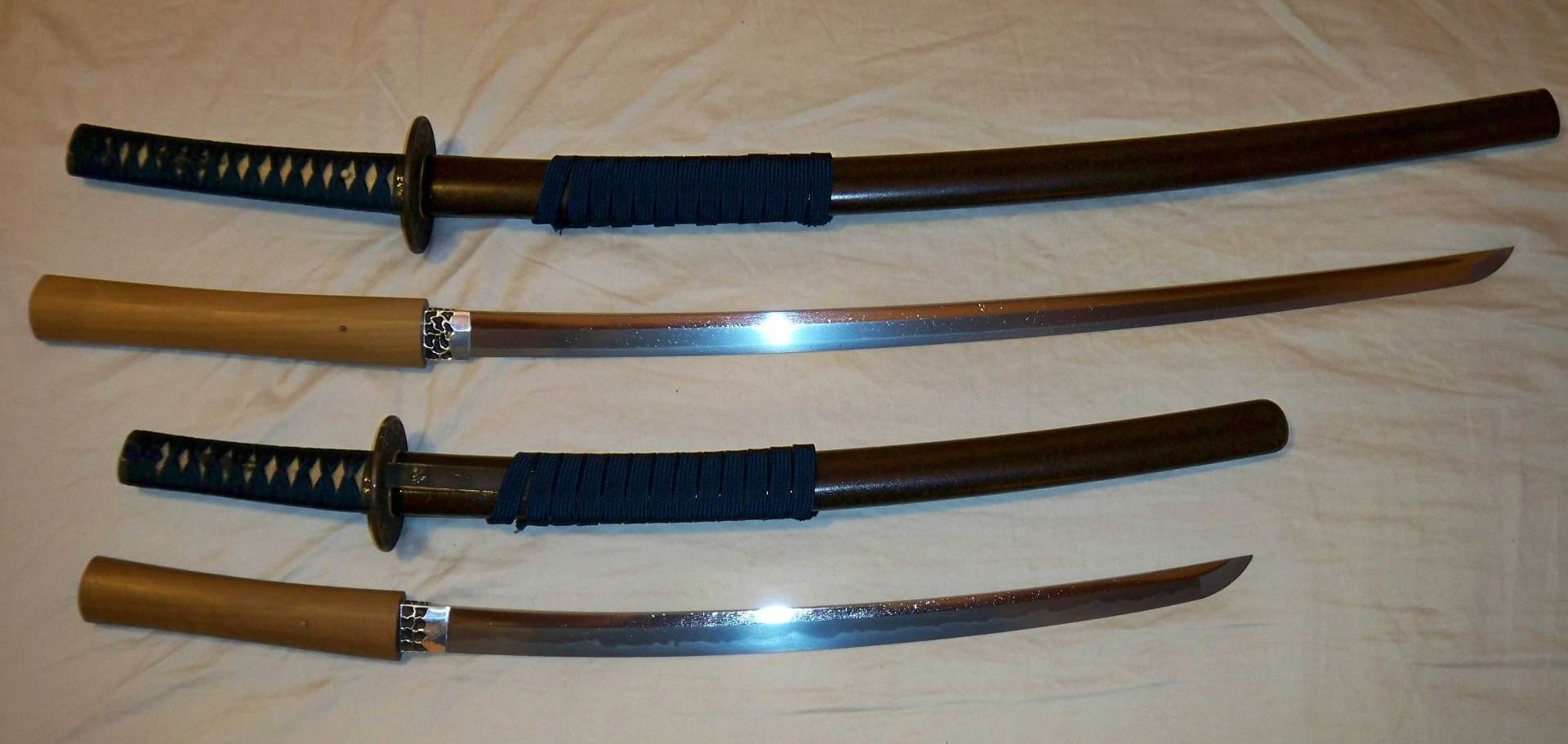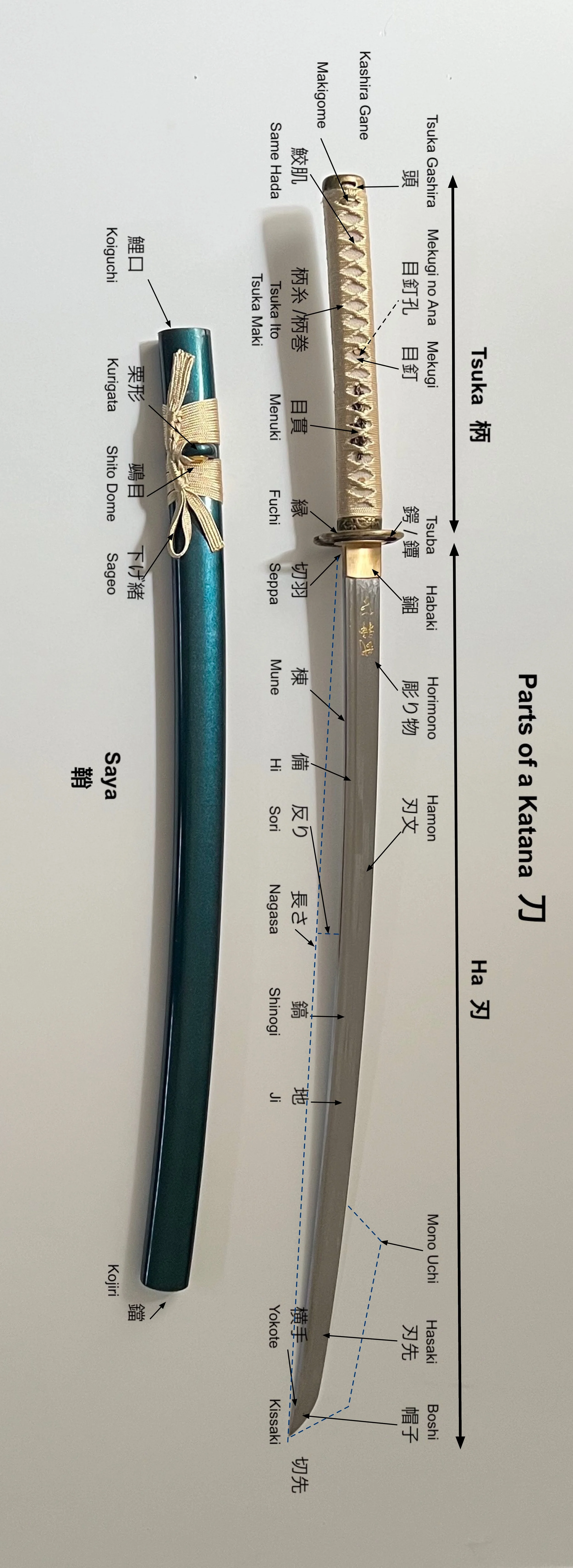
Katana
Japanese Sword
The most glorious position of the sword is in the saya…
Katana is the most famous among the japanese weapons. It is the soul of any warrior and has always been treated in Japan with utmost respect. Below are the most important parts of the Katana and its Saya. The information has been compiled from the sources for the non-specialists, and listed below. The literature for the specialists is infinitely more precise.
Basic parts of a Katana
Bōshi (帽子) – temper line (hamon) of the blade point (kissaki).
Fuchi (縁): The fuchi is a hilt collar between the tsuka and the tsuba.
Fukura (脹) – the cutting edge (ha) of the blade point (kissaki).
Ha (刃) – the tempered cutting edge of a blade. The side opposite the mune. Also called hasaki or yaiba.
Habaki (鎺): The habaki is a wedge shaped metal collar used to keep the sword from falling out of the saya and to support the fittings below; fitted at the ha-machi and mune-machi which precede the nakago.
Hamon (刃文) – border between the tempered part of the ha (cutting edge) and the untempered part of the rest of the sword; the temper-line. This line often appeas in shape of clouds, dragons, mountains, etc. This is the main point of the appreciation of the sword.
Hasaki (刃先) – see ha. Synonym of the blade (ha), sometime refers to the part close to the point of the blade with which the cutting is actually done.
Hi, (or bo-hi) the deep lines on the sword, appears historically rather late. Their aim is to make the blade lighter and stronger at the same time. They also simplify the flowing of blood towards outside when the body is hit with a sword. However, these are very quickly started to be considered as ornaments.
Hira (平) – see hiraji.
Hiraji (平地) or simply Ji (地) – curved surface between ridge (shinogi) and temper line (hamon). Also called hira. If polished, the hiraji appears blue-black.
Horimono (彫り物) – engravings. The first engravings were religious talismans, often featuring the mantras in sanskrit or gods and religious symbols. These further become purely decorative.
Ji (地) – area between the ridge (shinogi) and the hamon.
Jigane (地鉄) – generally used to refer to the material of the blade.
Kashira (頭): The kashira is a butt cap (or pommel) on the end of the tsuka. Also called Kashira Gane / Tsuka Gashira.
Katana (刀) – curved sword with a blade length (nagasa) longer than 60 cm (24 in). Worn thrust through the belt with the blade edge (ha) facing upward.
Kissaki (切先) – fan-shaped point of the blade; separated from the body of the sword by the yokote, fukura, ko-shinogi and mune.
Koiguchi (鯉口): The koiguchi is the mouth of the saya or its fitting; traditionally made of buffalo horn.
Kojiri (鐺): The kojiri is the end of the saya or the protective fitting at the end of the saya; also traditionally made of buffalo horn.
Kurigata (栗形): The kuri-kata is a knob on the side of the saya for attaching the sageo.
Makigome - special term referring to Tsuka maki.
Mei (名) – signature, usually engraved on the tang (nakago).
Mekugi (目釘): The mekugi is a small peg that sits in mekugiana made of bamboo or horn for securing the tsuka to the nakago.
Mekugi-ana (目釘穴): The mekugi-ana are the one or more holes in the tsuka and nakago for the mekugi.
Menuki (目貫): The menuki are ornaments on the tsuka (generally under the tsuka-ito); to fit into the palm for grip and originally meant to hide the mekugi.
Mono Uchi - defines the part of the blade used to cut.
Mune (棟) – back edge of a blade, i.e., the side opposite the cutting edge (ha).
Nagasa (長さ, length) – blade length measured from the point to the back edge notch (munemachi).
Nakago (茎, tang) – unpolished part of a blade that is concealed by the hilt (Tsuka).
Nakagojiri (茎尻) – end of the tang (nakago), i.e., the furthermost part from the tip of a blade.
Sageo (下げ緒): The sageo is the cord used to tie saya to the belt/obi when worn.
Same-hada (鮫肌): literally the pattern of the ray skin.
Same-kawa (samegawa) (鮫皮): same-kawa is the ray or shark skin wrapping of the tsuka (handle/hilt).
Saya (鞘): The saya is a wooden scabbard for the blade; traditionally done in lacquered wood.
Seppa (切羽): The seppa are washers above and below the tsuba to tighten the fittings.
Shinogi (鎬, ridge) – ridge running along the side of the sword, generally closer to the back (mune) than the cutting edge (ha). This is the widest part of the blade.
Shinogiji (鎬地) – flat surface between ridge (shinogi) and back edge (mune).
Shitodome (鵐目): an accent on the kurikata of the saya for aesthetic purposes; often done in goldish metal in modern reproductions.
Sori (反り, curvature) – curvature of the sword measured as the greatest perpendicular distance between the back edge (mune) and the chord connecting the back edge notch (munemachi) with the point of the blade.
Tsuba (鍔 or 鐔) – sword guard; generally a round metal plate with a central wedge shaped hole for the blade.
Tsuka (柄): The tsuka is the hilt or handle; made of wood and wrapped in samegawa.
Tsuka-ito (柄糸): Tsuka-ito the wrap of the tsuka, traditionally silk but today most often in cotton and sometimes leather.
Tsuka-maki (柄巻): the art of wrapping the tsuka, including the most common hineri maki and katate maki (battle wrap). There are also more elaborate and artistic wrapping techniques, like Jabara maki.
Yokote (横手) – line perpendicular to the ridge (shinogi) which marks off the kissaki from the rest of the blade.


